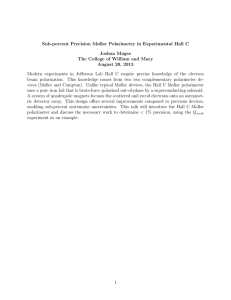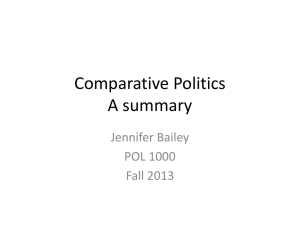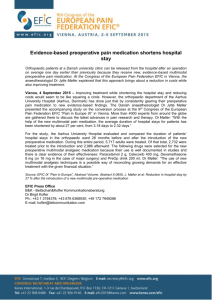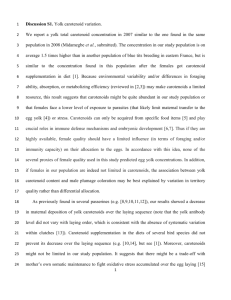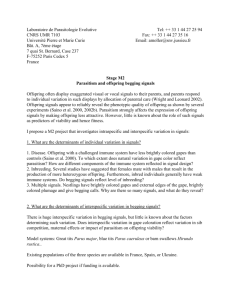IRREGULARITIES IN DATA REPORTED BY A.P. MØLLER
advertisement
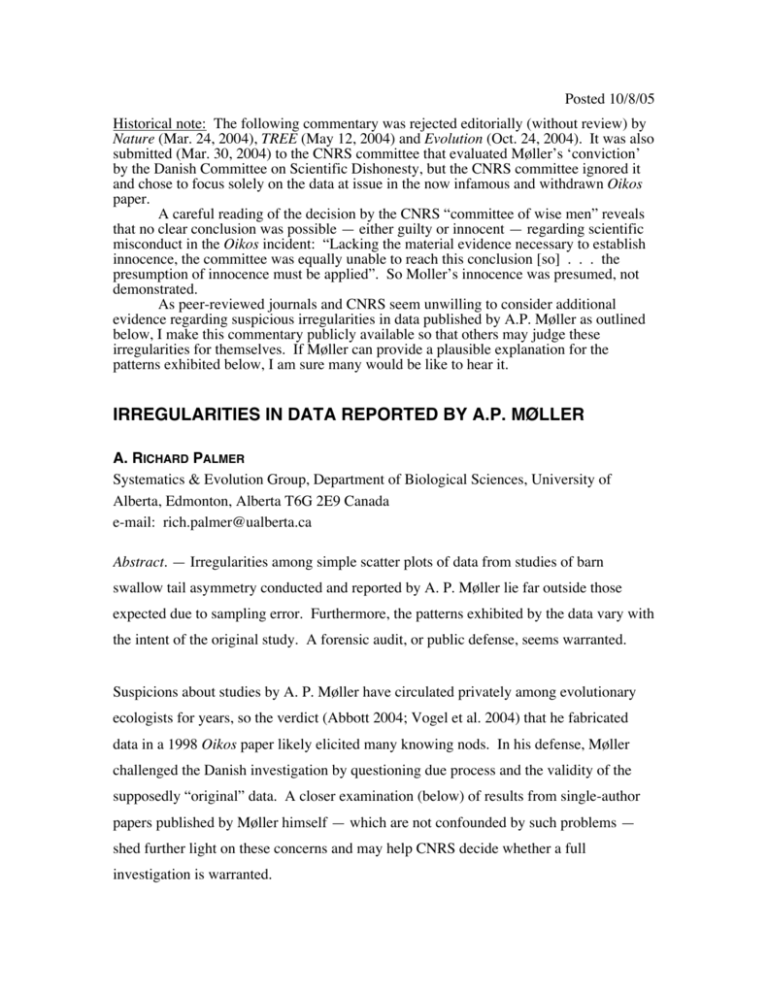
Posted 10/8/05 Historical note: The following commentary was rejected editorially (without review) by Nature (Mar. 24, 2004), TREE (May 12, 2004) and Evolution (Oct. 24, 2004). It was also submitted (Mar. 30, 2004) to the CNRS committee that evaluated Møller’s ‘conviction’ by the Danish Committee on Scientific Dishonesty, but the CNRS committee ignored it and chose to focus solely on the data at issue in the now infamous and withdrawn Oikos paper. A careful reading of the decision by the CNRS “committee of wise men” reveals that no clear conclusion was possible — either guilty or innocent — regarding scientific misconduct in the Oikos incident: “Lacking the material evidence necessary to establish innocence, the committee was equally unable to reach this conclusion [so] . . . the presumption of innocence must be applied”. So Moller’s innocence was presumed, not demonstrated. As peer-reviewed journals and CNRS seem unwilling to consider additional evidence regarding suspicious irregularities in data published by A.P. Møller as outlined below, I make this commentary publicly available so that others may judge these irregularities for themselves. If Møller can provide a plausible explanation for the patterns exhibited below, I am sure many would be like to hear it. IRREGULARITIES IN DATA REPORTED BY A.P. MØLLER A. RICHARD PALMER Systematics & Evolution Group, Department of Biological Sciences, University of Alberta, Edmonton, Alberta T6G 2E9 Canada e-mail: rich.palmer@ualberta.ca Abstract. — Irregularities among simple scatter plots of data from studies of barn swallow tail asymmetry conducted and reported by A. P. Møller lie far outside those expected due to sampling error. Furthermore, the patterns exhibited by the data vary with the intent of the original study. A forensic audit, or public defense, seems warranted. Suspicions about studies by A. P. Møller have circulated privately among evolutionary ecologists for years, so the verdict (Abbott 2004; Vogel et al. 2004) that he fabricated data in a 1998 Oikos paper likely elicited many knowing nods. In his defense, Møller challenged the Danish investigation by questioning due process and the validity of the supposedly “original” data. A closer examination (below) of results from single-author papers published by Møller himself — which are not confounded by such problems — shed further light on these concerns and may help CNRS decide whether a full investigation is warranted. In two early studies (Møller 1990; Møller 1992), Møller reported highly significant negative associations between tail asymmetry and tail length in male barn swallows (Hirundo rustica). Published scatter plots bear this out (Fig. 1a,b), and support his inference that males with longer tails were more fit (i.e., more symmetrical). However, when Rowe et al. (1997) noted that these data departed significantly from true fluctuating asymmetry [i.e., too few symmetrical and nearly symmetrical individuals were present among smaller males than expected due to normal sampling variation (shaded areas); p= 0.039 and P= 0.016, respectively], Møller rebutted with additional data (Møller 1999). These newer data revealed many more symmetrical and nearly symmetrical small males than reported earlier (compare shaded regions in Figs. 1c,d to those in Figs. 1a,b), which supported Møller’s (new) conclusion that true fluctuating asymmetry was observed at all tail lengths. Is it not odd that male barn swallows from a single population exhibit different patterns of asymmetry variation that correlate with the apparent intent of the study? How likely is it that — due to chance — small-sized, more symmetrical males were absent from earlier samples where one pattern was predicted by Møller (Figs. 1a,b), yet present in later samples when another pattern was predicted by Møller (Figs. 1 c,d)? In addition, although Møller insists he “excluded any individuals with broken or damaged feathers” (ibid, pg. 452), four males in the largest dataset (Fig. 1d) were far more asymmetrical than expected due to developmental instability (31, 41, 52, and 82% of tail length, respectively). Furthermore, some data from the earlier studies (circled points in Figs. 1a and b) appear to be missing from the pooled data (Fig. 1d). These suspicious patterns — coupled with earlier published evidence of selective reporting (Palmer 1999) and plagiarism (Houle 1998), and the recent verdict of data fabrication by the Danish Committee on Scientific Dishonesty (Abbott 2004; Vogel et al. 2004) — cast doubt upon a large body of research. One hopes that CNRS will persevere with a full forensic audit of all of Møller’s work. If legitimate explanations exist for the apparent contradictions posed by Fig. 1, they should be made public so that Møller, his employers, his supportive colleagues (Alatalo et al. 2004), and the agencies that fund his research, are not unjustly scandalized. 20 b) Møller 1992 a) Møller 1990 15 Tail asymmetry |R - L| (mm) 10 5 0 20 d) Møller 1999 fig. 2a c) Møller 1999 fig. 1a 15 10 5 0 80 90 100 110 120 130 140 90 Mean tail length (mm) 100 110 120 130 140 Figure 1. Unsigned asymmetry |right - left| versus mean length of outer tail feathers of male barn swallows, Hirundo rustica, from four different datasets collected from the Kraghede, Denmark, population by A. P. Møller (figure in original paper, sample size, year of data): a, Fig. 1, n= 96, 1989; b, Fig. 2a, n= 59, 1988; c, Fig. 1a, n= 88, 1997; d, Fig. 2a, n= 726, 1989-96. Data were digitized from the published figures and re-plotted on the same axes for easier comparison (some points at or near zero asymmetry for tails between 95 and 125 mm length in d could not be digitized with certainty because many points overlapped in the original figure). In d four points lay outside the graph boundaries (arrows), corresponding to tail asymmetries, from left to right, of 70, 36, 49, and 32 mm, respectively. Circled points in a and b: data missing from the pooled data in d. References Abbott, A. 2004. Prolific ecologist vows to fight Danish misconduct verdict. Nature 427:381. Alatalo, R.V., Aragón, S., Avilés, J. M., Barbosa, A., Bessa Gomes, C., Cadée, N., Christe, P., Cuervo, J. J., Díaz, M., Erritzøe, J., Galeotti, P., Garamszegi, L. Z., Gil, D., Gontard-Danek, M., Legendre, S., Martin, T. E., Martínez, J., Martín-Vivaldi, M., Martínez, J. G., Merino, S., Moreno, J., Mousseau, T., Ninni, P., Petrie, M., Pulido, F., Rubolini, D., Saino, N., Soler, J. J., Soler, M., Spottiswoode, C., Szép, T., Thornhill, R., Zamora, C. and Sacchi, R. 2004. Support for a colleague. Science 303:1612. Houle, D. 1998. High enthusiasm and low R-squared. Evolution 52:1872-1876. Møller, A. P. 1990. Fluctuating asymmetry in male sexual ornaments may reliably reveal male quality. Anim. Behav. 40:1185-1187. Møller, A. P. 1992. Parasites differentially increase the degree of fluctuating asymmetry in secondary sexual characters. J. Evol. Biol. 5:691-699. Møller, A. P. 1999. Condition-dependent symmetry is fluctuating asymmetry. J. Evol. Biol. 12:450-459. Palmer, A. R. 1999. Detecting publication bias in meta-analyses: A case study of fluctuating asymmetry and sexual selection. Amer. Nat. 154:220-233. Rowe, L., Repasky, R. R. and Palmer, A. R. 1997. Size-dependent asymmetry: Fluctuating asymmetry versus antisymmetry and its relevance to condition-dependent signaling. Evolution 51:1401-1408. Vogel, G., Proffitt, F. and Stone, R. 2004. Ecologists roiled by misconduct case. Science 303:606-609.
